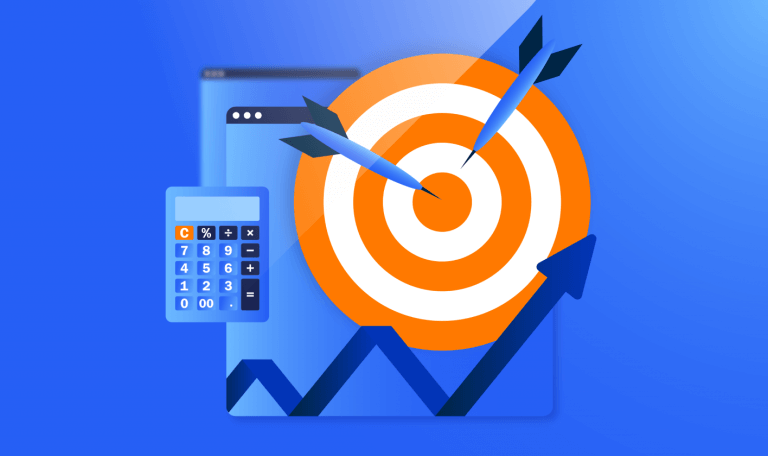How to Calculate Market Potential – A Beginner’s Guide

Assessing market potential is critical when you get ready to expand your business. It doesn’t matter if you’re established or in the start-up phase; knowing the potential size and value of your market is key.
In this post, we’ll explore the meaning of market potential in more detail to help you understand the aspects that influence it. There’s also an illustrated fictional example of potential market calculation and a guide to help you calculate market potential too.
What is market potential?
Market potential is an evaluation of the sales you can expect from a product or service you plan to offer in a market — the calculation factors in the size of the customer base and the demand. It always represents the upper limit of the market – in other words, the optimal outcome. You start by estimating potential per sales volume and then calculate revenue.
Here comes the practical example we promised to help you envision.
Let’s say you developed a cell phone case that optimizes videos you shoot for TikTok. It’s voice-activated and automatically optimizes lighting and sound, and that’s just the beginning. Sounds like a cool gadget, right?
You’ve sold it successfully in Asia and are now ready to expand into the U.S. Market potential research provides the data to calculate possible revenue from the potential available market. Volume represents the number of units you can expect to sell, and the value represents the revenue you make from it.
Market potential formula
To calculate market potential by value, use this market potential formula:
Market size x unit price = market potential.
Example of market potential calculation
Let’s apply the formula to our example. The market size or customer base would theoretically comprise all TikTok users in the U.S. According to Statista, that number will reach 84.9 million in 2022.
If every one of them bought your device at $10 – for the sake of simplicity – your revenue would amount to $849 million (84.9M sales x $10).
This is, of course, too good to be true. There are additional factors to consider to get to the realistic market potential for such accessories.
First off, considering market size alone isn’t enough. Not every TikTok user is a likely candidate for your gadget. Many social media users consume content, but don’t post original content of their own, let alone invest in video shooting equipment. Alternately, top influencers are set up with more sophisticated equipment.
Not to mention…
- What do competitors offer, and how strong are their products?
- What are the additional costs, and how high is your ROI?
- Is the TikTok trend likely to last?
Accurately assessing market potential is vital for your financial planning and success in the new market. Keep in mind it’s a snapshot in time, and market potential can fluctuate significantly.
How to conduct a market potential analysis
1. Identify market size and demand
The market size describes your potential customer base. It’s also referred to as the total addressable market or TAM. Out of the total population in your potential target market, you need to determine the number of prospects for whom your product is useful and relevant at all.
For the product in our example, you need to narrow down the number of TikTok users in the U.S.. Consider demographic aspects. There might be age groups that you need to deduct. You also want to understand product preferences and financial capabilities.
This means investigating consumer behavior to identify the level of interest in the type of product you offer. Out of all TikTok users, how many also invest in equipment and how many prefer affordable gadgets? You may need to cross-reference the audience for mobile phone accessories to get a better picture.
Examine search volume for relevant keywords or other accessories. The amount of traffic generated by relevant search terms indicates how much a product type is in demand. Understand the audience behind that traffic for the real goods.
In short, consider demographic factors, identify consumer preferences and financial capabilities, and anticipate how your product may change demand. This brings you to your serviceable addressable market or SAM.
2. Examine the competition
Competitors already occupy part of your potential market. You can challenge them with your new product, but you’re not likely to kick everyone out.
For a realistic estimation of the market potential, competitive analysis is a must. First, you identify your true competition. True competitors are businesses that offer a similar product to the same target audience. In highly competitive markets such as cars or clothing, you research the companies with the most similarities in the product they offer and who they offer it to – and at which price level.
In a more diverse market setting, you need to broaden your competitive benchmarking and include any products that solve the same problem or address the same need.
Back to the example, suppliers of ring lamps, microphones, etc. could be competitors.
To arrive at the actual market size to calculate market potential, assess your competitors’ market share, and get insights into their customer loyalty. The goal is to estimate how much of the market is still “open” and how big the chances are that you can grab your competitors’ share. This is called the serviceable obtainable market or SOM.
3. Evaluate market growth rate
Now that you have a better concept of the market you’re about to enter, the next question to answer is whether the market grows and how much.
First and foremost, be sure that your product will be in demand long enough for you to make a profit off it. It’s critical to determine market trends. Identifying trends will also help you determine the best time to launch your product.
To understand market growth, you want to analyze megatrends or macro trends. Find out how the market has developed over the past years. Dive deep into historical trends and unveil the factors that impacted them and caused shifts.
In our example, the market is very young, so you only need to look a few years back – lucky you. Get specific and identify the exact growth rate of the popular platform in the U.S. and see if usage is still increasing or if the curve is flattening.
Additionally, dig into the data for similar equipment, like equipment for shooting videos such as lamps and screams and microphones. Understand search trends, the demographic makeup of the audience, and more. The idea is to gauge the demand for your product better.
4. Calculate profitability
When you’ve estimated the realistic chunk of the market you can potentially conquer, you need to establish profitability. The potential market size may determine the price you can offer the product and how much profit you can gain.
Don’t forget that entering a new market generally involves additional costs. Be sure to avoid unpleasant surprises by considering things like packaging and shipping costs. Check import-export laws to discover possible tax or legal fees, certificates, or other less-sexy administrative expenses.
Next, you need to calculate your ROI and the time it will take to break even. Maybe you need to adjust your price level to increase your obtainable market or raise the price to cover your expenses.
Lastly, consider the type of product you’re offering. Can you expect repeat purchases from satisfied customers, or is this a one-time item that won’t require replacement? This affects the demand over time and your calculation of profitability in the long run.
5. Consider external influences
So far, we’ve looked at the market as if it was shielded from outside influences. However, that’s not what markets are. They are open spaces, and when it rains, their entire potential runs down the drain.
OK, so the actual weather isn’t a typical concern for digital products. But other factors deserve some thought. Recent or expected political, social, or economic changes can impact your ability to supply to a specific market, for example. The same goes for upcoming regulatory restrictions or existing local laws that could impact cost or lead time. Trade agreements can open new markets. Regional disputes or sanctions can slow down market activity, and the list goes on. Stay aware.
All the data you need to research market potential and audience
The most challenging factors to gauge are demand and your competitors’ strength. Why? Because you can’t get inside the audience’s or your competitor’s heads, and you don’t know what they’re really up to.
Here’s where Similarweb comes in. The platform uses different types of data sources and a robust algorithm to provide highly accurate market data, including coveted competitor intelligence.
To assess demand, investigate search volume. With the Similarweb Keyword Research Tool, you get data on the actual traffic to different sites generated from organic searches. For example, if you want to know the overall search volume for the term “iPhone accessories”, Similarweb shows you the sites that received the maximum traffic and the amount of traffic per site. Magic.
You can also easily view a breakdown of traffic share per competitor. Identify the market leaders per industry or category.
Use audience overlap to understand the market size and the competitive environment.
Investigate the audience and see which of the competitors’ audiences is closest to your target audience and in which areas. Understanding audience behavior will then help you determine potential marketing channels and strategies. But we’re getting ahead of ourselves. You’re still determining the potential of the market. And now that you know how, what’s stopping you?
Get further tutoring when you sign up to the Similarweb platform for free. Or why not request a demo? We’ll be on the lookout for your new product launch.
FAQ
What is the definition of market potential?
Market potential is the calculation of the maximum revenue for a product or brand in a specific market.
How do you describe the meaning of market potential?
Market potential factors in size of the potential market and demand for a product in that market. Calculating market potential means using market research and analysis to gauge the best possible sales results in a market.
What is potential market demand?
Potential market demand aims to determine how likely people are to buy a product. This includes the need for the product, level of awareness, popularity, and trust.
What is the market potential formula?
Market size x units per buyer = potential market volume
Market size x value per unit = potential market value
Track your digital metrics and grow market share
Contact us to set up a call with a market research specialist













